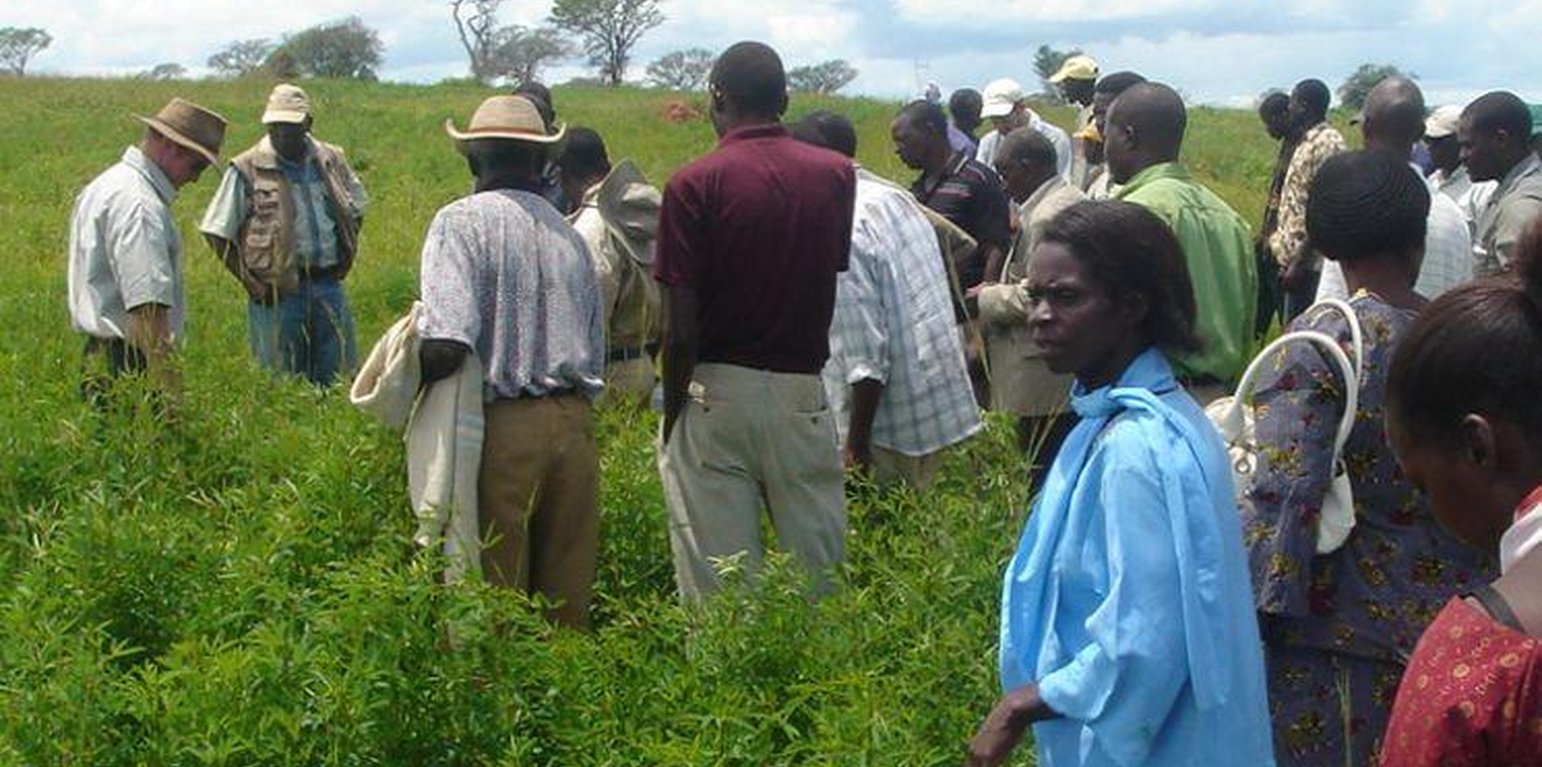Participatory Research and Development
(Zambia)
on-farm research
Description
This is a collaborative process between researchers and farmers for developing and adapting new technologies that focus on incorporating the perspectives and inputs from the farmers into the development process.
Aims / objectives: (1)To stimulate active farmer participation in the technology development process so that local conditions and perspectives are integrated in the process. (2)Build the capacity of farmers to identify problems and contribute to selecting/improving technology options. (3) Raise farmers’ yields in a sustainable manner and ultimately contribute to increased net farm income.
Methods: A series of on-farm experiments are set up to test a range of technology options. These trials are implemented by the farmers so that vital feedback on which technology works and why it does so is collected. Suggestions for improvements are also collected, reviewed and incorporated into new designs or all together new technologies developed. The process is repeated until spontaneous adoption is evident before the technologies are promoted widely.
Stages of implementation: (1) Preparation of trial protocols for technologies to be tested (2) Identification of farmers and mobilization into farmer groups (3) Capacity building and increasing the knowledge base of farmers to effectively participate and contribute to development process. (4) Setting up of on-farm trials (5) Monitoring trials and collecting data/feedback from farmers (6) incorporation of feedback into technology development process and conducting on-station trials (7) technologies adapted or developed and introduced and the process is repeated.
Role of stakeholders: The approach was designed by national specialists where ‘best-bet’ technologies were pre-selected for testing. The role of GART was that of research and training of trainers. The supervision of the farmers was carried out by government extension workers who were supervised by the researchers and GART field technicians. The farmers implemented the approach and the decision on which technology to adopt was made by them. The land users also participated in evaluating the technologies and made suggestions on possible improvements. The decision on how best to consolidate these suggestions and incorporate them into the technologies was made by the specialists in consultation with the land users.
Location
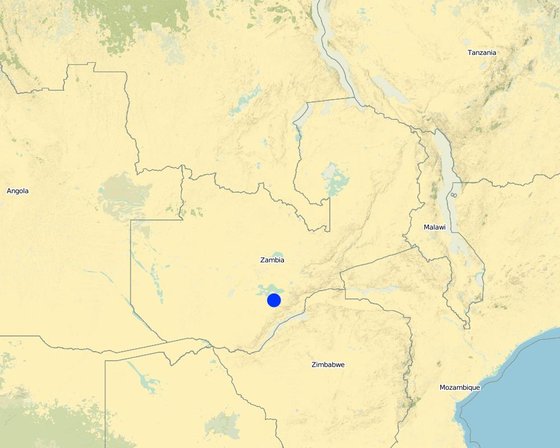
Location: Mazabuka/Magoye, Zambia, Zambia
Geo-reference of selected sites
Initiation date: 1995
Year of termination: n.a.
Type of Approach
-
traditional/ indigenous
-
recent local initiative/ innovative
-
project/ programme based
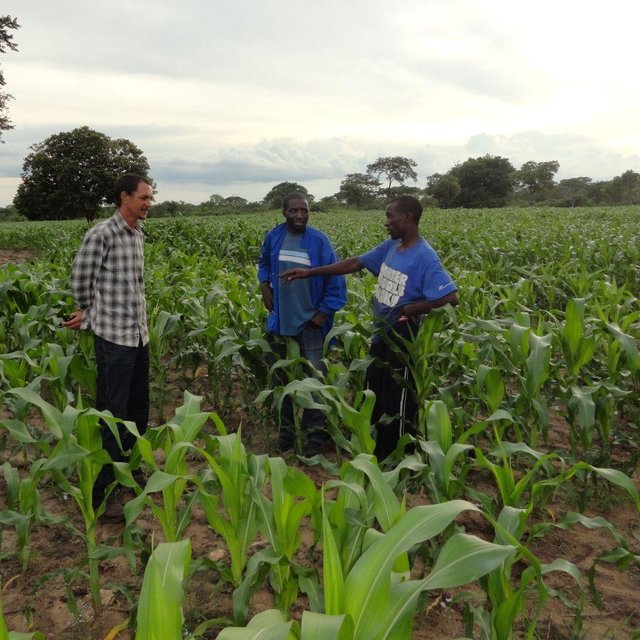
Discussing the performance of the Magoye Planter with a test farmer in a field planted with the same. (Arthur Chomba (Box 670577, Mazabuka, Zambia))
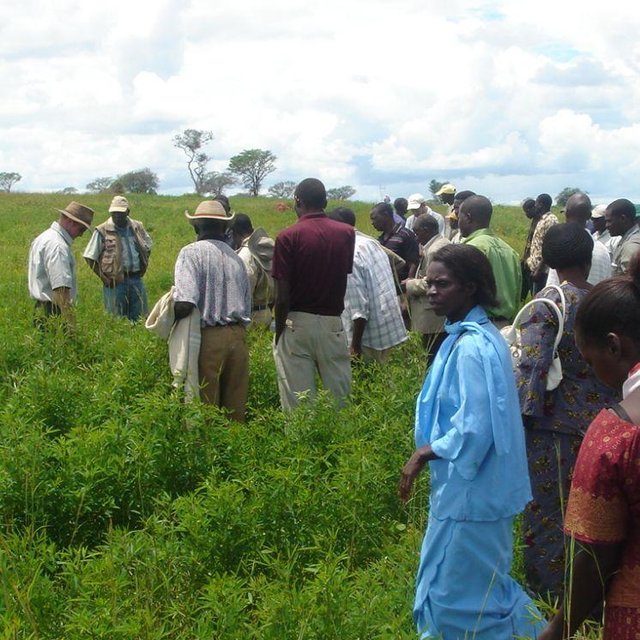
Farmers attending a field day (Arthur Chomba (Box 670577, Mazabuka, Zambia))
Approach aims and enabling environment
Main aims / objectives of the approach
The Approach focused mainly on SLM with other activities (Increasing agricultural productivity, improving livelihoods )
(1)To stimulate active farmer participation in the technology development process so that local conditions and perspectives are integrated in the process. (2)Build the capacity of farmers to identify problems and contribute to selecting/improving technology options. (3) Raise farmers’ yields in a sustainable manner through technology innovation and ultimately contribute to increased net farm income.
The SLM Approach addressed the following problems: Unsustainable farming practices leading to environmental degradation and low agricultural productivity
Conditions enabling the implementation of the Technology/ ies applied under the Approach
Conditions hindering the implementation of the Technology/ ies applied under the Approach
-
Social/ cultural/ religious norms and values: The participation of women not as much as that of men
Treatment through the SLM Approach: Women headed households were identified and targeting for inclusion in the project
-
Availability/ access to financial resources and services: The short cycle of projects and funding that made long-term planning difficult
Treatment through the SLM Approach: Collaborate with government structures and extension service to ensure sustainability of the project
-
Institutional setting: Weak collaboration between organizations promoting conservation agriculture (CA) leading to mixed messages being delivered to farmers
Treatment through the SLM Approach: Formation of the Conservation Farming Association (CAA) to synchronise messages and avoid duplication of efforts
-
Legal framework (land tenure, land and water use rights): Lack of secure land tenure leading to hesitancy to invest in long-term conservation efforts
Treatment through the SLM Approach: Emphasise the short-term benefits of conservation
The existing land ownership, land use rights / water rights moderately hindered the approach implementation Lack of secure land tenure discourages land user from seeking long-term conservation efforts
-
Knowledge about SLM, access to technical support: The failure of rural workshops to produce and supply the necessary equipment for the implementation of the approach
Treatment through the SLM Approach: Collaboration was initiated with mainstream equipment suppliers
-
Other: Low returns from the sale of the staple crop (maize) and hence low returns to farming general
Treatment through the SLM Approach: Encourage crop livestock integration and promote crop diversification
Participation and roles of stakeholders involved
Stakeholders involved in the Approach and their roles
| What stakeholders / implementing bodies were involved in the Approach? |
Specify stakeholders |
Describe roles of stakeholders |
| local land users/ local communities |
Community based organizations for HIV/AIDS affected people |
Most of the households are male headed. of the 250 farmers registered in Magoye, only 22 were female headed. |
| SLM specialists/ agricultural advisers |
Researchers and government extension |
|
| researchers |
Researchers and government extension |
|
| national government (planners, decision-makers) |
|
Government extension implemented the approach after training from GART. Politicians were lobbied to mainstream CA in govt programmes |
Involvement of local land users/ local communities in the different phases of the Approach
none
passive
external support
interactive
self-mobilization
initiation/ motivation
Approach inititated by specialists based on interactions with land-users from previous programmes
planning
Planning was done by specialists although farmers were informed and consulted at every stage
implementation
Land users implemented the approach with the help of specialists
monitoring/ evaluation
Monitoring/evaluation was done by the specialists together with the land users as well as external evaluators
Research
Research was done by the specialists together with the land users
Flow chart
Golden Valley Agricultural Research Trust (GART) is an autonomous and self-sustaining
Public Private Partnership organization in 1993 created by the Government of Zambia and the Zambia National Farmers Union GART is member of the Zambia National Farmers Union (ZNFU).
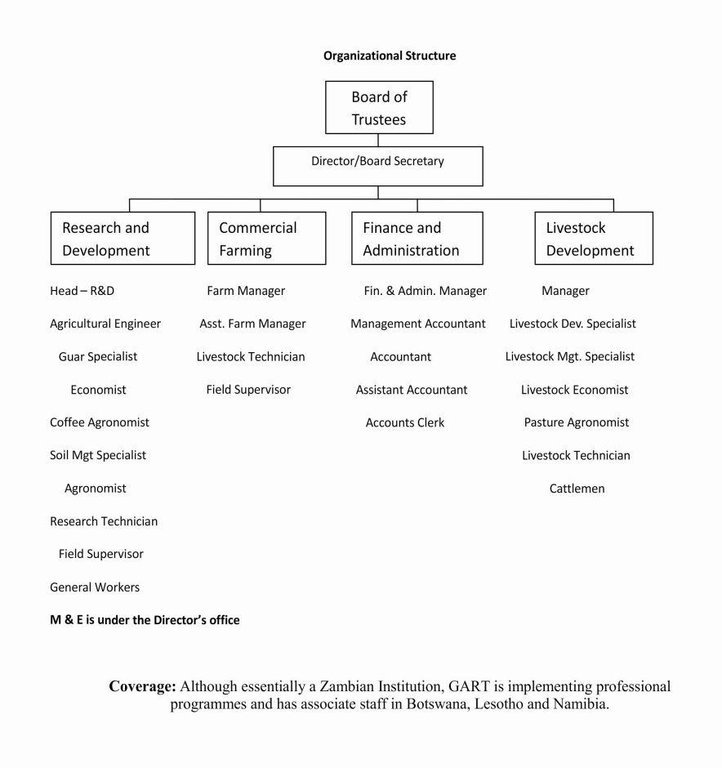
Author: Silenga Wamunyima (Mazabuka/Southern Province/Zambia)
Decision-making on the selection of SLM Technology
Decisions were taken by
-
land users alone (self-initiative)
-
mainly land users, supported by SLM specialists
-
all relevant actors, as part of a participatory approach
-
mainly SLM specialists, following consultation with land users
-
SLM specialists alone
-
politicians/ leaders
Decisions were made based on
-
evaluation of well-documented SLM knowledge (evidence-based decision-making)
-
research findings
-
personal experience and opinions (undocumented)
Technical support, capacity building, and knowledge management
The following activities or services have been part of the approach
-
Capacity building/ training
-
Advisory service
-
Institution strengthening (organizational development)
-
Monitoring and evaluation
-
Research
Capacity building/ training
Training was provided to the following stakeholders
-
land users
-
field staff/ advisers
Form of training
-
on-the-job
-
farmer-to-farmer
-
demonstration areas
-
public meetings
-
courses
Subjects covered
soil conservation and soil fertility improvement, how to use the conservation agricultural technologies, crop-livestock integration
Advisory service
Advisory service was provided
-
on land users' fields
-
at permanent centres
Name of method used for advisory service: Training of Trainers; Key elements: trainig of goverment extension workers and NGOs promoting of conservation agriculture (CA), on-farm demonstrations, field days
Advisory service is inadequate to ensure the continuation of land conservation activities; There are too few extension workers and there aren’t sufficient training manuals
Institution strengthening
Institutions have been strengthened / established
-
no
-
yes, a little
-
yes, moderately
-
yes, greatly
Describe institution, roles and responsibilities, members, etc.
Type of support
-
financial
-
capacity building/ training
-
equipment
Further details
Capacity building of local cooperatives and farmer associations, training of trainers and practical demonstrations
Monitoring and evaluation
bio-physical aspects were regular monitored by project staff, land users through observations; indicators: Soil properties, moisture conservation
bio-physical aspects were ad hoc monitored by project staff through measurements; indicators: soil miosture, soil fertility
technical aspects were regular monitored by project staff through observations; indicators: Yield, production area, labour, timeliness
technical aspects were None monitored by project staff through measurements; indicators: equipment breakdowns
socio-cultural aspects were None monitored by project staff through observations; indicators: Gender, mindset, status
economic / production aspects were None monitored through observations; indicators: Yields, labour inputs, costs, income, adoption
no. of land users involved aspects were monitored through observations
There were several changes in the Approach as a result of monitoring and evaluation: There was more emphasis on on-farm trials as the project went on with more training on weeding techniques and crop-livestock integration
There were several changes in the Technology as a result of monitoring and evaluation: The Magoye Ripper (T_ZAM003en) was modified to penetrate deeper and an altogether new technology called the Magoye Planter (Strip Tillage T_ZAM002en) was developed to overcome some of the constraints of the Magoye Ripper.
Research
Research treated the following topics
-
sociology
-
economics / marketing
-
ecology
-
technology
Research by GART focused on equipment development and adaptation of soil improvement technologies to make Conservation Agriculture (CA) a viable option for animal draft farmers
Research was carried out both on station and on-farm
Financing and external material support
Annual budget in USD for the SLM component
-
< 2,000
-
2,000-10,000
-
10,000-100,000
-
100,000-1,000,000
-
> 1,000,000
Precise annual budget: n.a.
Approach costs were met by the following donors: local community / land user(s) (Land preparation by land user(s)): 100.0%
The following services or incentives have been provided to land users
-
Financial/ material support provided to land users
-
Subsidies for specific inputs
-
Credit
-
Other incentives or instruments
Financial/ material support provided to land users
Mostly contributions from EU supplemented by finances from commercial activities i.e. commercial crop production and contract research
partly financed
fully financed
Labour by land users was
-
voluntary
-
food-for-work
-
paid in cash
-
rewarded with other material support
Impact analysis and concluding statements
Impacts of the Approach
No
Yes, little
Yes, moderately
Yes, greatly
Did the Approach help land users to implement and maintain SLM Technologies?
The farmers that adopted the Magoye Ripper were ploughing (pulverising) less thereby reducing erosion and loss of organic matter. However, some of the technologies have not been adopted on a wide enough scale to create an impact at community level. Even the farmers that did not adopt the technologies are now more aware of the need for soil conservation.
Did the Approach empower socially and economically disadvantaged groups?
HIV/AIDS affected families and female headed households were specifically targeted
Did the Approach improve issues of land tenure/ user rights that hindered implementation of SLM Technologies?
Apart from lobbying policy makers, issues of land tenure were beyond the scope of the approach
The problem is likely to be overcome in the near future. The problem has been acknowledged by politicians and addressed in the new draft constitution
Did other land users / projects adopt the Approach?
On-farm research has been adopted by the Conservation Farming Unit (CFU) who are the biggest player in promotion of Conservation Agriculture in Zambia. There are not many other research organizations in Zambia
Main motivation of land users to implement SLM
-
increased production
-
increased profit(ability), improved cost-benefit-ratio
-
reduced land degradation
-
reduced risk of disasters
-
reduced workload
-
payments/ subsidies
-
rules and regulations (fines)/ enforcement
-
prestige, social pressure/ social cohesion
-
affiliation to movement/ project/ group/ networks
-
environmental consciousness
-
customs and beliefs, morals
-
enhanced SLM knowledge and skills
-
aesthetic improvement
-
conflict mitigation
Sustainability of Approach activities
Can the land users sustain what hat been implemented through the Approach (without external support)?
Adoption rates for Conservation Agriculture are still fairly low indicating that the practice is still fairly new and the technologies still need to be adapted and refined to suit local conditions. The farmers still need technical support until the bottlenecks with the practices are addressed and there is evident spontaneous adoption. This all depends on how well research and planners respond to the current challenges.
Conclusions and lessons learnt
Strengths: land user's view
-
Farmers well informed of current developments and technology advancements (How to sustain/ enhance this strength: Training farmers on current developments and technology advancements)
Strengths: compiler’s or other key resource person’s view
-
Farmers organizations strengthened (How to sustain/ enhance this strength: Capacity building)
-
There is strong farmer involvement in technology adaptation
(How to sustain/ enhance this strength: Increase the farmers knowledge base to ensure effective participation)
Weaknesses/ disadvantages/ risks: land user's viewhow to overcome
Weaknesses/ disadvantages/ risks: compiler’s or other key resource person’s viewhow to overcome
-
Too little emphasis on knowledge transfer and too much on practical demonstrations and ‘how-to’ training.
Focus more on understanding principles and technology selection
References
Date of documentation: Jan. 16, 2013
Last update: Junie 26, 2017
Resource persons
-
Arthur Chomba (arthurchomba@yahoo.co.uk) - SLM specialist
-
Sharon Ndandula - SLM specialist
-
Alfred Katoweji - SLM specialist
-
Sylvester Chingulu - SLM specialist
-
Silenga Wamunyima (wamzysilenga@rocketmail.com) - SLM specialist
Full description in the WOCAT database
Documentation was faciliated by
Institution
- Golden Valley agricultural research trust (Golden Valley agricultural research trust) - Zambia
- Ministry of Agriculture of Zambia (MoA) - Zambia
Project
Key references
-
Impact study on the acceptance of the Magoye Ripper, Piet Stevens, David Samazaka, Ab Wanders, Douglas Moono, 2002 Conservation farming in Zambia, Steven Haggblade, Gelson Tembo, October 2003 Social-economic analysis of conservation agriculture in southern Africa, FAO, 2011Conservation farming in Zambia, Conservation farming unit (CFU), 2011: GART/free onlineINDABA Project, Michigan State University/free onlineFAO/free onlinecfu@zamnet.zm
-
Conservation farming in Zambia, Steven Haggblade, Gelson Tembo, October 2003: INDABA Project, Michigan State University/free online
-
Social-economic analysis of conservation agriculture in southern Africa, FAO, 2011: FAO/free online
-
Conservation farming in Zambia, Conservation farming unit (CFU), 2011: cfu@zamnet.zm
